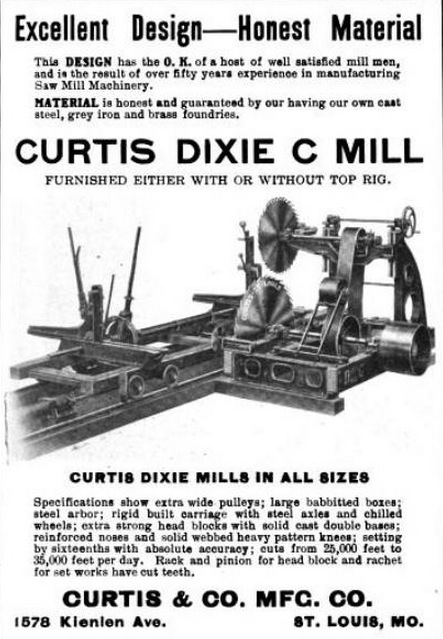This company was founded in 1854, and was manufacturing sawmills by the 1880s. By 1954 they were the Curtis Saw Division of Curtis Manufacturing Co. As far as we can tell, this division disappeared sometime in the 1950s or early '60s.

Advertisement from the 1911-04-15 "St. Louis Lumberman"
In the 1960s Curtis Manufacturing Co. was acquired by a St. Louis manufacturer on an acquisitions binge, Wyle Laboratories, and Curtis became Curtis Manufacturing, a Wyle Company. Curtis' St. Louis subsidiary made clutch disks and air compressors, and their Toledo subsidiary made pipe-threading equipment and dies.
By the mid-1970s the Curtis division was being poorly managed. It is not clear whether these problems existed before Wyle's acquisition or were created by Wyle's management. Either way, Wyle failed to understand and fix Curtis' problems, and then in 1976 they attempted to reduce costs by consolidating Curtis' St. Louis and Toledo operations into their St. Louis plant, selling off excess machines, and laying off a significant portion of the workers. At this point they discovered that years of product changes existed only in the heads of their workers and essential knowledge left with those who had been let go. As well, machines that performed essential steps in manufacturing had been sold off. Problems continued as Wyle tried to force profitability by shipping product regardless of quality concerns. At the end of 1978 Wyle sold the division for $5.6 million, to Wyle employee Ken Carpenter, who operated them as Curtis-Toledo, Inc.
Carpenter quickly discovered the extent of the issues and incrementally improved the processes and the management to return them to profitability. He was successful and Curtis-Toledo remains in business today as FS-Curtis, part of the Fusheng Group of companies.
Information Sources
- 136-page catalog ca. 1910, that says the company was founded in 1854.
- Used machine in ca. 1920 catalog.
- Listed in 1955-56 Hitchcock's Wood Workers Digest Directory as Curtis Saw Division of Curtis Manufacturing Co.
- Listed in C. H. Wendel's The Circular Sawmill, which notes that Curtis's "Single Giant Mill" could handle a single 72" blade, or a 64" bottom saw and a 36" top saw. The carriage was 24 feet long. Wendel shows a couple of Curtis designs from the 1880s.
- Listed in Kenneth Cope's American Cooperage Machinery and Tools, page 48, which mentions manufacture of a felloe sawing machine in 1880 and a 1905 maker of barrel. keg, stave, carriage builders' and felly machines.
- The history from 1962 to 1981 is from an excellent 1981 article from Inc magazine written by Harrison L. Moore.